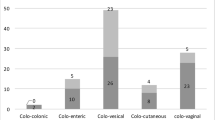Abstract
Background: Increased experience and improved instrumentation have lead to a reduction in morbidity and a commensurate increase in the spectrum of laparoscopic indications. The purpose of this study was to assess the feasibility of laparoscopic surgery in patients with gastrointestinal fistulas.
Methods: Between March 1993 and March 1995, patients with gastrointestinal fistulas who were laparoscopically treated were analyzed for age, gender, diagnosis, type of procedure, operative time, conversion rate, length of postoperative hospitalization, time until oral intake and return of bowel function, morbidity, and mortality.
Results: Ten patients (five females; five males) with a mean age of 49.7 (range 20–86) years were preoperatively diagnosed as having the following fistulas: colocutaneous fistula due to diverticulitis (one), enterocolic fistula (two)—due to Crohn's ileocolitis (one) and due to diverticulitis (one)—pouchvaginal fistula after restorative proctocolectomy for familial adenomatous polyposis (two), colofallopian fistula due to diverticulitis (one), rectourethral fistula due to Crohn's disease (one), high transsphincteric fistula due to perianal Crohn's disease (one), enteroenteric fistula due to Crohn's disease (one), and colovesical fistula due to diverticulitis (one). Procedures performed consisted of sigmoidectomy with coloproctostomy (four), ileocolic resection (two), small-bowel resection with ileostomy (one), and diverting loop ileostomy (three). A complex jejunal enterotomy was noted in one (10%) patient. The mean operative time was 195 (range 75–360) min and mean postoperative hospital stay was 6.1 (range 3–12) days. Two additional cases were converted to open procedures for extensive disease (one) and adhesions (one). The patients started oral intake after a mean of 2.2 (range 1–5) days and bowel function returned after a mean of 3.4 (range 2–7) days. One patient required laparotomy on postoperative day 7 for a malrotated loop ileostomy.
Conclusions: Laparoscopic colorectal surgery is feasible in patients with simple lower gastrointestinal fistulas. The morbidity rate of 10% and length of hospitalization of 6 days are similar to results after laparoscopic procedures for ``simpler'' colorectal pathology. However, the 30% conversion rate is higher, attesting to the challenging nature of these conditions.
Similar content being viewed by others
Author information
Authors and Affiliations
Additional information
Received: 30 April 1996/Accepted: 5 July 1996
Rights and permissions
About this article
Cite this article
Joo, J., Agachan, F. & Wexner, S. Laparoscopic surgery for lower gastrointestinal fistulas . Surg Endosc 11, 116–118 (1997). https://doi.org/10.1007/s004649900310
Published:
Issue Date:
DOI: https://doi.org/10.1007/s004649900310




